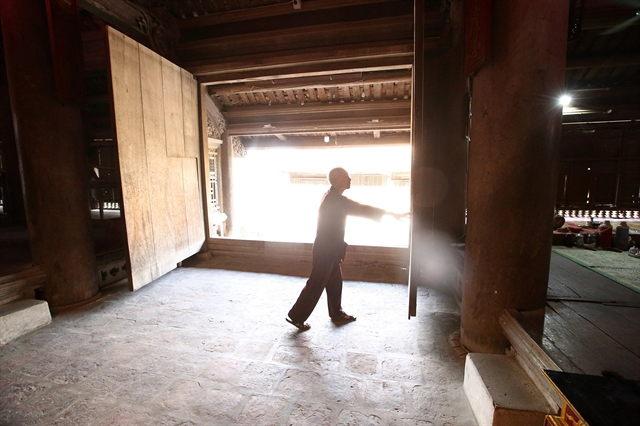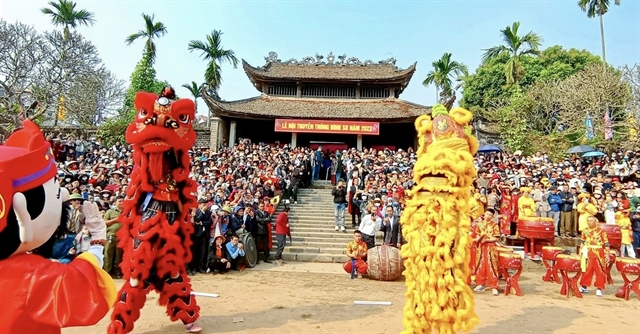
So Communal House is considered the most beautiful in the ancient area of Xứ Đoài. — Photo dantri.com.vn
By Lâm Giang
Considered the most beautiful Communal House in the area, So Communal House stands in the ancient area of Xứ Đoài west of the capital, in So Village, Cộng Hòa Commune, Quốc Oai District, Hà Nội.
Since ancient times, Xứ Đoài has been an expansive land to the west of Thăng Long imperial city and is known as the cradle of ancient Vietnamese civilization. It was here that the Hùng Kings founded the country and established the capital. Xứ Đoài is also renowned as the birthplace of many talented individuals and the guardian of numerous precious tangible and intangible cultural treasures. It encompasses Sơn Tây Town and the districts of Quốc Oai, Thạch Thất, Ba Vì, and Đan Phượng.
Although the name Xứ Đoài is no longer in use, the region still preserves hundreds of ancient communal houses. Among them, the ancient communal house of So Village holds the highest rank and occupies a significant position within the ancient architectural heritage of the north.
So Communal House originated as a small temple during the Đinh Dynasty. During the reign of Lê Trung Hưng in 1673, the temple underwent renovation and expansion, transforming into a communal house that was completed in 1674.

So Communal House was recognised as a national relic by the Ministry of Culture, Sports and Tourism. — Photo dantri.com.vn
The communal house is highly regarded and recognised by experts as an epitome of architectural excellence. It is dedicated to the worship of three generals who assisted King Đinh Tiên Hoàng in his battle against 12 independent feudal warlords for control of the country during the mid-10th century.
To this day, the communal house proudly displays 40 đạo sắc phong (documents that transmit the king's orders to confer titles on individuals) ranging from the second year of Hoằng Định (1601) of the Lê Dynasty to the ninth year of Khải Định (1924) of the Nguyễn Dynasty, alongside ancient parallel sentences.
Situated only about 40km from the center of Hà Nội, So Communal House enjoys a prime location amidst picturesque green mountains and a charming river.

The communal house spans a total area of 1,100sq.m. — Photo dantri.com.vn
"The communal house is situated on a spacious plot of land, with its front facing the river and the back nestled against the mountain. In front of the communal house's entrance is a large semicircular pond, considered a gathering point for water and blessings for the villagers," shared local resident Vương Trí Quy.
Visitors reach the 1,100sq.m communal house by passing through a three-passage gate, which features two floors, three compartments, and four roofs. The gate's intricate carvings are particularly noteworthy, especially the depiction of two dragons flanking the moon on the roof and the four sacred animals at the base of the wooden pillars.
Inside the communal house, there are seven compartments, two lean-tos, 32 ironwood pillars arranged in six horizontal rows, and an ironwood floor. The main chamber is located behind an altar dedicated to the three generals of the Cao family.

The communal house is highly regarded and recognised by experts as an epitome of architectural excellence. — Photo dantri.com.vn
The decorative paintings within the communal house exhibit a variety of motifs and patterns, blending different styles to create a diverse and richly adorned architectural space. From embossed stylized flowers and leaves like pine, chrysanthemum, bamboo, and apricot, to intricately carved dragon images, the decorative elements contribute to a multidimensional and sophisticated ambiance.
So Communal House also serves as the venue for three major festivals held annually by the villagers of Cộng Hòa Commune, including the largest village festival, which takes place from the 8th to the 11th day of the 2nd month on the lunar calendar.

So Village’s festivals often take place at So Communal House. — Photo ketnoithuonghieu.vn
In 1980, So Communal House was recognised as a national relic by the Ministry of Culture, Sports, and Tourism. VNS
OVietnam